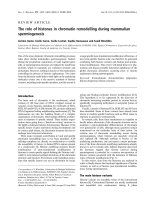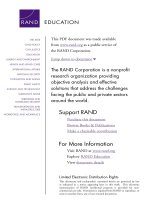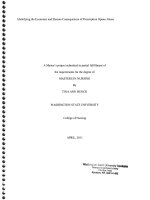The investigation of transcription related protein protein interactions of histones in saccharomyces cerevisiae
Bạn đang xem bản rút gọn của tài liệu. Xem và tải ngay bản đầy đủ của tài liệu tại đây (8.91 MB, 134 trang )
THE INVESTIGATION OF TRANSCRIPTION-
RELATED PROTEIN-PROTEIN INTERACTIONS
OF HISTONES IN SACCHAROMYCES
CEREVISIAE
ZHAO JIN
NATIONAL UNIVERSITY OF SINGAPORE
2013
THE INVESTIGATION OF TRANSCRIPTION-RELATED
PROTEIN-PROTEIN INTERACTIONS OF HISTONES IN
SACCHAROMYCES CEREVISIAE
ZHAO JIN
(M. Sc. (Molecular Engineering of Biological and Chemical
Systems), NUS)
A THESIS SUBMITTED
FOR THE DEGREE OF DOCTOR OF PHILOSOPHY
DEPARTMENT OF MICROBIOLOGY
NATIONAL UNIVERSITY OF SINGAPORE
2013
I
ACKNOWLEDGEMENTS
I would like to express my gratitude to all those who gave me the possibility to
complete this thesis. I want to thank the Department of Microbiology, Yong Loo Lin
School of Medicine, National University of Singapore for giving me the opportunity and
scholarship to pursue my PhD study in the first instance.
I am deeply indebted to my supervisor Associate Professor Dr. Norbert Lehming
whose help, stimulating suggestions and encouragement helped me through this academic
program. Without him, this thesis quite simply would not have been possible. It’s not that
it might have come together in a different or lesser form – it’s that it would not have
happened at all. As far as I can tell, he is the most tolerant boss with a lot of patience and
he’s also been a great friend.
I would also like to acknowledge and extend my heartfelt gratitude to my former
colleagues from Dr. Lehming’s Lab, who have supported me in my research work. I want
to thank them for all their help, support, interest and valuable hints. Especially I am
obliged to Dr. He Hongpeng, Dr. Chew Boon Shan, Dr. Kevin Ang, Ms Lim Mei Kee, Ms
Linda Lee and Madam Chew Lai Ming.
I have been truly blessed with caring parents and great friends whose patient love
enabled me to complete this work. Mr. Oh Teck Fang is a great guy, who has accepted
and cherished me as I am, bringing light and warmth to my darkest hours of life. Mr. Khin
Maung Cho is a terrific adviser and a very supportive and generous person who have
offered me so much advice and help over the years. Madam Chew Lai Ming is like my
mother in Singapore, always treating me as her own daughter. Linda Lee is a very loyal
friend, cheering for every progress I have made, no matter how little it is. I want these
people to know that their care has meant and means a lot to me.
Thanks to Maomi, the most excellent cat on earth, for being such a good company.
II
TABLE OF CONTENTS
ACKNOWLEDGEMENTS ································································· I
TABLE OF CONTENTS ···································································· II
LIST OF ABBREVIATIONS ······························································ IV
LIST OF TABLES ··········································································· IV
LIST OF FIGURES ·········································································· V
SUMMARY ··················································································· VI
CHAPTER 1 INTRODUCTION ··························································· 1
1.1 Chromatin structure and regulation of transcription ······························ 1
1.1.1 Chromatin structure ····················································································· 1
1.1.2 Epigenetic control of gene expression ································································ 3
1.2 Histone variants and gene control ······················································ 7
1.2.1 H2A.Z (Htz1) and the transcriptional regulation in Saccharomyces cerevisiae ··············· 12
1.3 Yeast as a model eukaryote ······························································ 13
1.3.1 Features of the yeast as a eukaryotic model organism ·············································· 13
1.3.2 Genetic nomenclature for Saccharomyces cerevisiae ··············································· 14
1.3.3 Yeast vectors and transformation ······································································· 15
1.3.4 URA3 gene ································································································ 17
1.3.5 Plasmid shuffle ··························································································· 18
1.3.6 The yeast GAL genes and their expression control ·················································· 19
1.4 Alanine-scanning mutagenesis ························································· 20
1.5 Phenotypic analysis ······································································· 21
1.5.1 Antimycin A (AA) sensitivity – Indicator for defects in the transcription activation of the GAL
genes by Gal4p ·································································································· 21
1.5.2 6-Azauracil (6-AU) sensitivity – Indicator for defects in transcription activation by Ppr1p of
the URA3 gene or defects in transcription elongation ······················································ 22
1.5.3 3-Amino-1, 2, 4-triazole (3-AT) sensitivity – Indicator for defects in transcription activation of
the HIS3 gene by Gcn4p ······················································································· 23
1.6 Multicopy suppressor screening ························································ 24
1.7 Split-ubiquitin system ···································································· 25
1.8 Chromatin immunoprecipitation assay ··············································· 27
1.9 Implications of histone modifications in human diseases ························· 31
1.10 Aim of the study ··········································································· 33
CHAPTER 2 MATERIALS AND METHODS ········································· 34
III
2.1 Materials ························································································ 34
2.1.1 Yeast Strains ······························································································ 34
2.1.2 E. coli strains ····························································································· 35
2.1.3 Plasmids ··································································································· 35
2.1.4 Primers ···································································································· 36
2.1.5 Media ······································································································ 36
2.2 Methods ························································································· 37
2.2.1 Construction of histone single-point mutants (for alanine scanning) ······························ 37
2.2.2 Phenotypic test (spot assay) ············································································ 38
2.2.3 Multicopy-suppressor screening ······································································· 38
2.2.4 Western blotting ·························································································· 39
2.2.5 RNA isolation ···························································································· 40
2.2.6 Quantitative reverse-transcription PCR ······························································· 40
2.2.7 Chromatin immunoprecipitation ······································································· 41
2.2.8 GST pull-down assay and immunoprecipitation ····················································· 41
2.2.9 Split-ubiquitin assay ····················································································· 42
CHAPTER 3 ALANINE SCANNING AND PHENOTYPIC TESTS FOR
HISTONE H2A AND H4 ···································································· 43
3.1 Abstract ························································································· 43
3.2 Results ··························································································· 43
3.2.1 Alanine-scanning mutagenesis and phenotypic analysis of histone H2A ························· 43
3.2.2 Alanine-scanning mutagenesis and phenotypic analysis of histone H4 ··························· 50
3.2.3 The H2A mutations R30A and E57A weakened the interaction with Gal4p and caused the gal
phenotype ········································································································ 57
3.3 Discussion ······················································································ 58
CHAPTER 4 INVESTIGATION OF THE GLUCOSE REPRESSION
DEFECTIVE PHENOTYPE OF HISTONE MUTANTS ···························· 63
4.1 Abstract ························································································· 63
4.2 Results ··························································································· 63
4.2.1 Glucose repression defective histone mutants ························································ 63
4.2.2 Suppressor screening ···················································································· 65
4.2.4 H4 K91Q, but not H4 K91R, caused a glucose repression defect ································· 70
4.2.5 Glucose repression defects of HDAC gene deletion strains ········································ 71
4.3 Discussion ······················································································ 74
CHAPTER 5 INVESTIGATION OF THE INTERACTIONS BETWEEN
HISTONES AND MIG PROTEINS ······················································ 75
5.1 Abstract ························································································· 75
5.2 Results ··························································································· 75
5.2.1 Mig1p interacts with core histones ···································································· 75
5.2.2 Several histone H4 mutant proteins that are defective for glucose repression are also defective
for the interaction with Mig1p ················································································ 76
5.3 Discussion ······················································································ 77
IV
CHAPTER 6 HTZ1 INTERCONVERTS CHROMATIN STATES ················ 79
6.1 Abstract ························································································· 79
6.2 Results ··························································································· 79
6.2.1 Transcriptional activation causes short-term memory ··············································· 79
6.2.2 A mixed population of repression-deficient and repression-competent HTZ1 cells ··········· 85
6.2.3 The transcription status of the episomal GAL1 promoter in HTZ1 cells is stable ·············· 87
6.6.4 The transcription status of the chromosomal GAL1 promoter in HTZ1 cells is also stable ··· 88
6.6.5 The growth on U plates and F plates reflects the GAL1 transcription status ····················· 91
6.6.6 Galactose induction evicts nucleosomes from the GAL1 locus ···································· 94
6.6.7 Nucleosome occupancy reflects the transcription status of the GAL1 locus ······················ 96
6.3 Discussion ······················································································ 98
CHAPTER 7 CONCLUSION ···························································· 104
REFERENCES ·············································································· 107
LIST OF ABBREVIATIONS
AA: antimycin A
ChIP: chromatin immunoprecipitation
HAT: histone acetyltransferase
HDAC: histone deacetylase
HPTM: histone post-translational modification
NTP: nucleoside triphosphate
ORF: open reading frame
RNAII: RNA polymerase II
TBP: TATA-binding protein
UAS: upstream activation sequence
USP: ubiquitin specific protease
3-AT: 3-amino-1, 2, 4-triazole
6-AU: 6-azauracil
LIST OF TABLES
Table 1.1 Names of the genes and their encoded proteins in this study ……………… 15
Table 4.1 Screen for suppressors of glucose repression defective histone mutants … 65
Table 4.2 Genes located on the multi-copy plasmids that suppressed the glucose
repression defect caused by H4 N25A and H4 K91A ……………………… 69
V
LIST OF FIGURES
Figure 1.1 Architecture of a chromosome 2
Figure 1.2 Crystal structure of the nucleosome core particle 3
Figure 1.3 GAL genes transcription upon galactose induction 20
Figure 1.4 Split-ubiquitin system 26
Figure 1.5 Summary of chromatin immunoprecipitation methodology 30
Figure 3.1 Growth defects and temperature sensitivity of cells expressing histone H2A
alanine point mutant proteins in place of wild-type H2A 45
Figure 3.2 Antimycin A sensitivity of histone H2A alanine point mutant strains 46
Figure 3.3 3-Aminotriazole sensitivity of histone H2A alanine point mutant strains 47
Figure 3.4 6-Azauracil sensitivity of histone H2A alanine point mutant strains 49
Figure 3.5 Growth defects and temperature sensitivity of cells expressing histone H4
alanine mutant proteins in place of wild-type H4 53
Figure 3.6 Antimycin A sensitivity of histone H4 alanine point mutant strains 54
Figure 3.7 3-Aminotriazole sensitivity of histone H4 alanine point mutant strains 55
Figure 3.8 Summary of phenotypes displayed by histone H2A mutants 56
Figure 3.9 Summary of phenotypes displayed by histone H4 mutants 56
Figure 3.10 H2A R30A and H2A E57A mutant strains were defective for the protein-
protein interaction with Gal4p 58
Figure 4.1 Histone mutant strains defective for glucose repression 65
Figure 4.2 Multi-copy suppressors of the glucose repression defect caused by H4
N25A…………………………………………………………………………………… 66
Figure 4.3 Multi-copy suppressors of the glucose repression defect caused by H4
K91A….………………………………………………………………………………….67
Figure 4.4 The H4 K91A mutation reduced the protein interactions with the four core
histones 70
Figure 4.5 The role of H4 K91 in transcriptional regulation 71
Figure 4.6 Glucose repression defects of HDAC gene deletion strains 73
Figure 5.1 Mig1p interacts with core histone proteins 76
Figure 5.2 Protein-protein interaction of histone H4 with Mig1p, Mig2p and Mig3p 77
Figure 6.1 The repression status of the GAL1 promoter in HTZ1 cells is stable 81
Figure 6.2 A Titration scheme: transcriptional activation causes short-term memory.… 82
Figure 6.2 B Titration scheme: transcriptional repression is stable.…………………… 83
Figure 6.2 C Titration scheme: transcriptional derepression is stable……………………84
Figure 6.3 The repression status of the chromosomal GAL1 promoter in HTZ1 cells is
stable 90
Figure 6.4 The growth on U and F plates reflects the transcription status of the GAL1
promoter 93
Figure 6.5 Galactose induction evicts nucleosomes from the GAL1 locus 95
Figure 6.6 Nucleosome occupancy reflects the repression status of GAL1 97
Figure 6.7 Htz1 is required to establish glucose repression in all cells 103
VI
SUMMARY
Alanine-scanning mutagenesis of the histones H2A and H4 was performed in the
model eukaryote Saccharomyces cerevisiae. Wild-type histones were replaced by the
mutant proteins via plasmid shuffle, and the resulting mutant strains were screened for
growth defects reflecting defects in transcriptional activation and repression of reporter
genes. Histone mutant proteins that conferred phenotypic defects were tested for defects
in protein-protein interactions with the help of the split-ubiquitin system. H2A E57A,
which conferred the gal phenotype when expressed in place of wild-type H2A (indicative
of defects in transcriptional activation of the GAL genes by Gal4p), was also defective for
the protein-protein interaction of H2A with Gal4p. One possible explanation of this result
is that Gal4p has to interact with H2A when it binds to its sites in the enhancers of the
GAL genes. H4 Y51A, which caused mis-expression of a reporter fusion of the GAL1
promoter to the URA3 open reading frame under repressive conditions (indicative of
defects in transcriptional repression of the GAL1 promoter by Mig1p), was also defective
for the protein-protein interaction of H4 with Mig1p. One possible explanation for this
result is that Mig1p has to interact with H4 when it binds to its sites in the silencer of the
GAL1 gene. H4 K91A, which also caused a glucose repression defect of the GAL1
promoter, was defective for the protein-protein interactions with the other core histones.
One possible explanation of this result is that glucose repression requires stable
nucleosomes. The H2A variant H2A.Z was found to be required for both galactose
induction and glucose repression of the GAL1 gene. The GAL1 mRNA was rapidly
degraded when cells were exposed to glucose, which explains why the role of H2A.Z in
glucose repression had not been observed in previous studies.
1
CHAPTER 1 INTRODUCTION
1.1 Chromatin structure and regulation of transcription
1.1.1 Chromatin structure
If laid out end to end, the DNA in a single human individual would stretch to 5×10
10
km, 100 times of the distance between the Earth and the Sun (Latchman, 2010). Clearly,
therefore, the DNA must be compacted in some way to fit inside a tiny cell. In the
eukaryotic nucleus, genomic DNA is wrapped around the histone octamer to form the
basic repeating unit of chromatin, the nucleosome. Each nucleosome is separated by a
linker region of DNA of 55-75 bp in length that is bound by histone H1 (Bednar et al.,
1998). When isolated under conditions of low ionic strength, chromatin in its extended
form (10 nm fiber) looks like beads (nucleosomes) on a string (DNA) in the electron
microscope. The 10 nm fiber is then wrapped into a 30 nm spiral called a solenoid, where
histone H1 and regulation of histone modifications are involved to maintain the
chromosome structure. In heterochromatin and in the mitosis chromosome, the 30 nm
fiber is further compacted by forming loops which are very closely packed, resulting in a
10,000-fold compaction of the genomic DNA (Hyde, 2009), (Figure 1.1).
In the nucleosome, core histones function as spools for 147 base pairs of DNA to
wrap around in ~1.7 left-handed superhelical turns (Kornberg and Lorch, 1999). There are
four core histones in all eukaryotes: H2A, H2B, H3 and H4. They are small, basic
proteins (rich in lysine and arginine), with a net positive charge that facilitates their
binding to the negatively charged DNA and neutralizes the net negative charge on the
DNA molecule to allow further folding to occur.
2
Figure 1.1 Architecture of a chromosome (Courtesy: Darryl Leja, National Human
Genome Research Institute)
The DNA in each chromosome is wrapped around spools consisting of histone proteins,
and the spooled DNA folds up still more. Collectively, the DNA complexed to proteins is
known as chromatin.
Amino acid sequences of histones are remarkably well conserved among eukaryotes,
for example, the peptide sequence of histone H4 is 92% identical between yeast and
human (Matsubara et al., 2007), indicating the key role of the histones in nucleosome
structure. Each of the four core histones has a similar structure, with an N-terminal tail
and a helical region which consists of three -helices separated by two loops. The -
helical region forms a specific structure, known as the histone fold, which allows
individual histones to associate with one another. The flexible N-terminal tails of histones,
which extend beyond the surface of the nucleosome particle, are where most post-
translational modifications take place. Based on the crystal structure of the nucleosome,
the histone octamer is generally depicted as a kernel of a H3
2
-H4
2
tetramer associated
with two H2A-H2B dimers (Arents et al., 1991; Luger et al., 1997), (Figure 1.2).
The significance of nucleosome structure in terms of gene regulation is that the
positioning of DNA within the nucleosome dictates the accessibility of a gene to the
3
general transcriptional machinery and RNAPII. The accessibility of a gene is further
influenced by epigenetic factors, such as DNA methylation and posttranslational histone
modifications that close or open chromatin structure leading to inactive or active
transcription, respectively (Latham and Dent, 2007).
Figure 1.2 Crystal structure of the nucleosome core particle
The 147-bp DNA is wrapped around the histone octamer in ~1.7 turns of a left-handed
superhelix. The histone octamer consists of two copies each of histones H2A (yellow),
H2B (red), H3 (blue), and H4 (green), (Luger et al., 1997).
1.1.2 Epigenetic control of gene expression
The term “epigenetic” was first introduced by Conrad Waddington in 1942
(Waddington, 1942) to describe “the interactions of genes with their environment that
bring the phenotype into being”. Currently, it includes all features such as chromatin and
DNA modifications that are inheritable and stable over rounds of cell division, but do not
alter the nucleotide sequence within the underlying DNA (Tollefsbol, 2011).
4
1.1.2.1 DNA methylation
DNA methylation is the most studied epigenetic process, which occurs at the carbon
5-position of the cytosine base within the context of CpG dinucleotides, and is catalyzed
by DNA methyltransferases (DNMTs) (Clark et al., 1995). It is now well established that
DNA methylation generally associates with silent chromatin which is inhibitory to
transcription initiation (Klose and Bird, 2006). One mechanism proposed for gene
silencing by DNA methylation is mediated by proteins containing methyl-binding
domains (MBD), which specifically recognize and bind to methylated DNA and repress
transcription indirectly via recruitment of corepressors that modify chromatin (Clouaire
and Stancheva, 2008).
Although cytosine methylation is a common DNA modification in most eukaryotic
organisms including plants, animals, and fungi (Law and Jacobsen, 2010), species such as
yeast and many invertebrates, including the nematode C. elegans and the fly D.
melanogaster, contain either no or barely detectable amounts of methylated cytosine in
their genomes (Hutchins et al., 2002; Tang et al., 2012). Histone modifications are the
main epigenetic regulatory mechanism in these organisms.
1.1.2.2 Histone modifications
The nucleosome organization of chromosomes has a generally repressive effect on
gene expression, because access to the transcription machinery is physically impeded by
histones. Modifications of histones typically occur as part of the process for activating
gene transcription.
The covalent modifications of histones include acetylation, methylation,
ubiquitylation, sumoylation and ADP-ribosylation of lysine residues, methylation of
arginine residues, and phosphorylation of serine, threonine and tyrosine residues. Around
200 post-translational modifications of histones have been reported occurring at
5
approximately 60 different sites, most of which are clustered in the unstructured N-
terminal tails of histones (Kouzarides, 2007). The diversity of histone post-translational
modifications (HPTMs) has led to the proposal of the histone code hypothesis. It
postulates that the combination or sequence of these modifications determines the
outcome of gene expression (Strahl and Allis, 2000).
In general, active transcription correlates with acetylated histones H3 and H4, while
reversal of acetylation is correlated with transcription repression. Several previously
known coactivators are shown to contain histone acetyltransferase (HAT) activity, which
is necessary for maximal transactivation of their target genes (Sterner and Berger, 2000),
and studies on transcriptional corepressor also revealed that corepressors function by
recruiting histone deacetylases (HDACs) to the promoter (Struhl, 1998).
Unlike acetylation, histone phosphorylation can mediate seemingly contradictory
outcomes, even at a given particular residue: phosphorylation of serine 10 on histone H3
N-terminal domain. This histone modification is very well correlated with mitotic
condensation of chromosomes, which is generally repressive for gene transcription,
especially in higher eukaryotes (Nowak and Corces, 2004). On the other hand, the same
phosphorylation mark on H3 Ser10 is also associated with activated gene transcription
(Lo et al., 2001).
In contrast to acetylation and phosphorylation, where the target residue can be
modified by only a single moiety, lysines can be modified up to three methyl groups (i.e.,
mono-, di- or trimethyl). These distinct methylation levels of a given residue have been
linked to distinct genomic activities (Lee et al., 2005). For instance, while all the
euchromatic regions tested show dimethylation of histone H3 Lys4 in budding yeast,
trimethylation of the same residue preferentially occurs at promoters and 5’ regions of
active ORFs (Bernstein et al., 2002; Santos-Rosa et al., 2002). Methylation also plays a
dual role in gene transcription: the general pattern of histone methylation in
6
heterochromatin is di- and trimethylation of lysine residues 9 and 27 of histone H3
(H3K9me2 and K3K27me3), while monomethylation of H3K9 and H3K27 along with
H3K4me, H3K79me and H4K20me are associated with active chromatin (Schones and
Zhao, 2008).
Currently, there are two mechanisms which have been commonly considered as the
way how HPTMs affect gene regulation (Latham and Dent, 2007). First, HPTMs may
somewhat affect the structure of chromatin, facilitating certain chromatin conformations
or higher-order structures to permit protein factors (such as transcription factors) to reach
their DNA targets. For instance, acetylation on lysine residues can reduce the positive
charge of histones, thereby weakening their interaction with negatively charged DNA and
increasing nucleosome fluidity, resulting in a more open chromatin structure (Workman
and Kingston, 1998). Second, covalently modified histone residues may provide specific
binding surfaces to recruit certain effector proteins which may have an activating or
repressive effect on transcription. Over the past 10 years, multiple families of conserved
domains that recognize modified histones have been discovered. For example,
bromodomain-containing proteins can specifically bind acetylated lysine residues, while
chromodomain-containing proteins can specifically bind methylated lysines (Bottomley,
2004). However, the biological outcome of certain HPTMs does not only depend on the
binding partners of modified histones, but also heavily depends on the chromatin and
cellular context of such modifications (Berger, 2007).
Similar to the studies on gene function in the 1980s that evidenced the need for a
detailed map of the genome, the study of epigenetics requires a detailed map of epigenetic
modifications at a genomic scale. Thanks to technological advances, scientists now are
able to map epigenetic marks, such as DNA methylation, histone modifications and
nucleosome positioning in large-scale epigenomics studies, making epigenetics one of the
most rapidly expanding fields in biology.
7
1.2 Histone variants and gene control
In addition to post-translational modifications of histones, the incorporation of variant
histones into nucleosomes provides another regulatory mechanism of gene expression by
directly or indirectly altering the permissiveness of chromatin (Henikoff and Ahmad,
2005). These histone variants, as they came to be called, differ at the primary sequence
level from their canonical relatives; and have been known as minor variants because of
their rarity compared with major histones. They have been found in all eukaryotes and are
generally not essential, but provide specificity to chromatin domains by possibly
influencing the stability of nucleosomes or interacting with trans-acting factors (Ausio
and Abbott, 2002).
With the exception of H4, all core histones have variant counterparts, sharing 40-80%
amino acid identity with them (Pusarla and Bhargava, 2005). In most organisms, the
major histones are each encoded by multiple copies of genes, whereas histone variants are
usually present as single-copy genes (Kamakaka and Biggins, 2005). Major histones are
primarily expressed during the S phase of the cell cycle, composing the bulk of the
cellular histones, and deposited in chromatin during DNA replication (Marzluff and
Duronio, 2002). In contrast, histone variants are generally expressed throughout cell cycle
and are incorporated into chromatin in a replication-independent manner at specific
regions of genome (Henikoff et al., 2004). Besides, histone variants, like canonical
histones, are subject to numerous covalent modifications, adding levels of complexity to
the roles chromatin plays in various cellular processes (Hake and Allis, 2006; McKittrick
et al., 2004).
Although mammals have many histone variants, only two are shared among all
eukaryotes: a histone H3 variant that plays an essential role in centromere function) and
an H2A variant, termed H2A.Z in mammals and Htz1 in Saccharomyces cerevisiae.
The centromere-specific H3 variant (CenH3) that replaces the major-type histone H3
8
in specialized nucleosomes at the centromere is the first histone variant to be implicated
in specification and inheritance of a chromatin state (Palmer et al., 1991). The rapid
evolving CenH3 protein can be found in all eukaryotes and is required for accurate
chromosome segregation in every organism examined (Kamakaka and Biggins, 2005). It
has been known as Cse4 (c
hromosome segregation) in Saccharomyces cerevisiae, CID
(centromere identifier) in Drosophila melanogaster and CENP-A (cen
tromere protein-A)
in Homo sapiens. Although the homology between these CenH3 proteins is limited to
their C-terminal histone fold domains (HFD), sharing only 34 -57% sequence identity
(Chen et al., 2000), their essential N-terminal domains (END) are even more divergent in
both length and amino-acid sequence, which is unalignable between CenH3 proteins from
distant taxa (Cooper and Henikoff, 2004). Both HFD and END are essential for CenH3
function. Although only HFD contains the centromere targeting information (Keith et al.,
1999; Sullivan et al., 1994), END is required for the binding of various kinetochore
proteins. And the great divergence in the N-terminal tails of CenH3 proteins is most likely
manifesting its rapid adaptive evolution with the kinetochore proteins it recruits (Cooper
and Henikoff, 2004).
In Saccharomyces cerevisiae, Cse4 replaces the major histone H3 in centromeric
chromatin, and directs assembly of kinetochore, together with H4 and a nonhistone
protein Scm3, which replaces the H2A-H2B dimer from preassembled Cse4-containing
histone octamer (Mizuguchi et al., 2007).
Unlike other histone variants, which possess domains distinct from those of canonical
histones, H3.3 differs from canonical histone H3 (also known as H3.1/2) at only four
amino acid positions. However, this rather subtle sequence difference is necessary and
sufficient to account for unique functions of H3.3 (Ahmad and Henikoff, 2002). In
metazoans, H3.3 is specially enriched within actively transcribed genes and the H3
replacement by it has been shown to promote the initial gene activation (Schwartz and
9
Ahmad, 2005). Phylogenetic analysis also suggests that the metazoan H3.3 and the major
H3 of Saccharomyces cerevisiae shares the common ancestor with conserved functions
(Elsaesser et al., 2010). This is consistent with its role in histone replacement at active
genes and promoter (Ahmad and Henikoff, 2002), as the yeast genome is continually in a
transcriptionally active or competent state (Lohr and Hereford, 1979).
Among the four core histones, H2A has the largest number of variants, including
H2A.X, H2A.Z, macroH2A and H2A-Bbd (H2A B
arr body deficient) (Redon et al., 2002).
Some H2A variants, like H2A.Z and H2A.X are conserved through evolution, playing
important roles in transcription regulation or double-strand DNA repair, while others such
as macroH2A and H2A-Bbd are restricted to vertebrates, marking alternative epigenetic
states of chromosomes (Malik and Henikoff, 2003). The greatest region of variability
among H2A variants is found to be the C-terminal tail (Ausio and Abbott, 2002), which is
essential for the stability of nucleosomes (Eickbush et al., 1988).
H2A.X is a histone H2A variant in higher eukaryotes, but the “normal” histone H2A
in Saccharomyces cerevisiae (Downs et al., 2000). The core sequence of H2A.X is nearly
identical to that of the major vertebrate H2A, while its C-terminal tail is longer and
contains a SQ(E/D)(I,L,F,Y) motif, which is also found in the C-terminal tails of some
major H2As from lower eukaryotes, suggesting its conserved functions (Thatcher and
Gorovsky, 1994). The serine in the SQ motif (Ser129 in budding yeast and Ser139 in
mammals) is the site of rapid phosphorylation by phosphatidyl inositol 3’-kinase-related
kinases (PIKK, such as ATM in human cells and Mec1 in yeast), in response to DNA
double-strand breaks (Morrison and Shen, 2005). The addition of a bulky phosphate
group with negative charges may change the chromatin structure surrounding the DNA
lesion so as to allow greater accessibility of the DNA to modulating enzymes and repair
factors and facilitate the assembly of repair complexes at lesion sites (Downs et al., 2000).
Unlike H2A.X, which could be found throughout the genome, the vertebrate-specific
10
H2A variants, macroH2A is enriched in the inactive X-chromosome (Chadwick and
Willard, 2002). It has been shown that the globular C-terminal domain of macroH2A can
inhibit transcription factors binding and its histone-fold domain can interfere with
chromatin remodeling by SWI/SNF complexes, thus suggesting its general role in
establishment of silent chromatin structure (Angelov et al., 2003). Besides, its C-terminal
“macro” domain contains a leucine-zipper motif that has been implicated in protein
dimerization. Such dimerization in macroH2A-containing nucleosomes might facilitate
inter-nucleosome interactions, thereby promoting the compaction of large chromatin
domains (Sarma and Reinberg, 2005). In mammalian female cells, macroH2A appears to
replace canonical H2A during X chromosome inactivation and may be involved in the
generation or maintenance of the Barr body.
In contrast, the other vertebrate-specific H2A variant, H2A-Bbd, named for its
relative depletion from Barr bodies in mammals, is largely excluded from the inactive X-
chromosome, but enriched in nucleosomes associated with transcriptionally active region,
colocalizing with the acetylated histone H4 (Chadwick and Willard, 2001). The lack of a
significant C-terminal tail of H2A-Bbd has been postulated to destabilize the nucleosome,
thus aiding in ease of nucleosome displacement during transcription, and consistent with
its localization to the active X chromosome and autosomes (Gautier et al., 2004).
The histone H2A variant H2A.Z (also known as H2A.Z/F, H2AvD, hv1 or Htz1) is
highly conserved throughout evolution with 90% sequence homology between species
(Iouzalen et al., 1996), even more similar across species than is canonical H2A, and
makes up approximately 5~10% of all cellular H2A proteins in most organisms tested to
date (Leach et al., 2000; Redon et al., 2002). However, the sequence similarity between
H2A.Z and canonical H2A is only 60%, which suggests unique and important functions
for H2A.Z (Jackson and Gorovsky, 2000; Thatcher and Gorovsky, 1994). It has been
shown that H2A.Z is important in several processes, such as gene activation,
11
heterochromatin-euchromatin boundary formation and cell-cycle progression (Dhillon et
al., 2006; Meneghini et al., 2003; Zhang et al., 2005).
The crystallographic structure data of H2A.Z-containing nucleosome showed a subtle
destabilization of the interaction between the H2A.Z/H2B dimer and the H3/H4 tetramer
(Suto et al., 2000). And the biochemical analysis of chromatin fibers also showed
reduced salt stability of nucleosomes containing H2A.Z (Zhang et al., 2005). Taken
together, it seems that unstable H2A.Z-containing nucleosomes may result in loss of
nucleosomes from specific region of DNA, allowing transcriptional regulatory proteins to
bind (Zhang et al., 2005).
Studies of genome-wide localization of H2A.Z has revealed that it is incorporated
into nucleosomes near, but not at centromeres, at the borders of heterochromatic domains,
and near the promoters of 63% genes (Guillemette et al., 2005; Li et al., 2005; Raisner et
al., 2005; Zhang et al., 2005). Given its widespread locations in most promoters, one
might anticipate that H2A.Z plays important roles in transcription.
The gene encoding H2A.Z has been shown to be essential in most organisms, from
ciliated protozoans to mammals (Liu et al., 1996), whereas yeasts with deletion of the
H2A.Z gene are viable and exhibit a variety of phenotypes, which could help us
understand multiple regulatory roles of H2A.Z playing in diverse biological processes
(Carr et al., 1994; Jackson and Gorovsky, 2000). Given my research interest in the gene
regulation by histones, the following section will be devoted to the important roles that
H2A.Z plays in transcriptional regulation in Saccharomyces cerevisiae.
12
1.2.1 H2A.Z (Htz1) and the transcriptional regulation in Saccharomyces cerevisiae
The earliest evidence of H2A.Z correlating with transcriptional activity comes from
Tetrahymena thermophila, where H2A.Z (termed as hv1) is preferentially associates with
the transcriptionally active macronucleus rather than with the silent micronucleus,
implying a positive role for H2A.Z in gene transcription (Allis et al., 1980). However,
about 30 year later, the molecular function of H2A.Z in transcription remains obscure.
In Saccharomyces cerevisiae, Htz1, the ortholog of mammalian H2A.Z, is the sole
histone H2A variant and is encoded by HTZ1 (Jackson et al., 1996). The loss of has
relatively minor effect on gene expression profile Htz1 in Saccharomyces cerevisiae,
typically affecting only the transcriptional kinetics of a subset of inducible genes
(Meneghini et al., 2003).
It has been proposed that Htz1 positively regulates gene transcription by modulating
interactions with RNA polymerase II associated factors (Adam et al., 2001; Marques et al.,
2010; Wan et al., 2009) and by remodeling chromatin structure (Santisteban et al., 2000).
Genome-wide location studies have revealed that Htz1 preferentially associates with the
two nucleosomes flanking the nucleosome free region (NFR) of promoters (Albert et al.,
2007). The distinctive enrichment of Htz1 at promoter proximal nucleosomes has led to
the pervasive view that H2A.Z is the key regulator of transcription that creates a more
permissive environment for transcription activation, but we still lack a clear
understanding of precisely how this substitution affects nucleosome stability and
interactions (Rando and Winston, 2012).
H2A.Z occupancy has been found to negatively correlate with transcription levels,
with H2A.Z being highly enriched in most gene promoters but depleted upstream of very
highly transcribed genes, which has been interpreted to suggest that Htz1 helps to poise
promoters for activation (Zanton and Pugh, 2006; Zhang et al., 2005).
The biological importance of fine nucleosome positioning is made clear by the
13
topological relationship of transcription factor binding sites and transcriptional start sites
with the DNA wrapped in a nucleosome (Albert et al., 2007). In yeast, it has been
demonstrated that transcription factor binding sites tend to be rotationally exposed on the
H2A.Z nucleosome surface near its border, while transcriptional start sites tend to reside
about one helical turn inside the nucleosome border (Albert et al., 2007). Others have
observed that H2A.Z incorporation within a nucleosome leads to repositioning of a subset
of nucleosomes to a new position. Indeed, this stabilization leads to less variability in
H2A.Z nucleosome positions in a population of cells, when compared to H2A
nucleosome positions. One can imagine that depending on where nucleosomes are
repositioned, positive or negative effects on gene expression could be observed (Marques
et al., 2010).
1.3 Yeast as a model eukaryote
1.3.1 Features of the yeast as a eukaryotic model organism
Because of the remarkable conservation of basic biological structures and processes
throughout evolution, the results from basic research on model organisms such as the
bacteria Escherichia coli, the yeast Saccharomyces cerevisiae, and the fruit fly
Drosophila melanogaster, typically would apply more generally. The yeast
Saccharomyces cerevisiae is perhaps the best-studied eukaryotic organism and also the
first eukaryote of which the complete genome was sequenced (Goffeau et al., 1996).
Since its introduction as a model organism for molecular biology around 1960, it has
yielded a variety of industrial and medical applications beneficial to human life.
The yeast is microscopic and easy to manipulate like bacteria, but it is a eukaryote,
evolutionarily closer to animal than plant. In fact, many human genes related to disease
have orthologues in yeast (Ploger et al., 2000), and the high conservation of metabolic
and regulatory mechanisms has contributed to the wide-spread use of yeast as a model
14
eukaryotic system for diverse biological studies. It is non-pathogenic, so can be handled
with few precautions. It has a relative short life cycle, so that a large number of
generations occur within a short time, making it possible to obtain data readily over many
generations. Normal laboratory haploid yeast strains have a doubling time of
approximately 90 min in yeast-extract peptone dextrose medium and approximately 140
min in synthetic medium during the exponential phase of growth (Sherman, 2002).
The genome of yeast is relatively small, constituting 12,052 kb, which is only about
3.5 times larger than that of E. coli and about 200 times smaller than the human genome,
and only 3.8% of its ORFs contain introns (Spingola et al., 1999). Laboratory yeast
strains can be maintained in stable haploid state with a set of well-characterized 16
chromosomes due to a mutation in the gene encoding HO endonuclease required for
homothallic switching, which is essential for the utility of yeast as a genetic model system.
The highly versatile and efficient DNA transformation system established in yeast
makes it particularly accessible to gene cloning and genetic engineering techniques.
Plasmid can be introduced into yeast cells either as replicating molecules or by
integration into the genome. And the integrative recombination of transforming DNA in
yeast proceeds exclusively via homologous recombination. Cloned yeast sequences can
therefore be directed at will to specific locations in the genome.
The yeast combines several advantages of many model organisms, making it a
powerful model genetic system to functionally dissect many highly conserved eukaryotic
cellular processes.
1.3.2 Genetic nomenclature for Saccharomyces cerevisiae
The universally accepted genetic nomenclature for the yeast is as the following: each
gene is designated by three italicized uppercase letters followed by a number (e.g., GEN1),
while proteins encoded by GEN1, for example, can be denoted Gen1p. Names of all the
15
genes and their encoded proteins in this study are listed in Table 1.1.
Gene name Protein name
GAL1
Gal1p
GAL4
Gal4p
HHF1/HHF2
H4
HHT1/HHT2
H3
HTA1/HTA2
H2A
HTB1/HTB2
H2B
HTZ1
Htz1 (H2A.Z in yeast)
URA3
Ura3p
Table 1.1 Names of the genes and their encoded proteins in this study
For the four core histones in yeast, there are two copies of genes encoding for each of
them. Cells are not viable with both copies of the histone genes deleted.
Symbols are commonly used to designate certain types of experimentally manipulated
gene structures. The symbol “”can denote a complete ORF deletion. Gene disruptions
are typically represented with a double colon “::” and gene fusion constructs are often
designated with a dash (Demerec et al., 1966).
Phenotypes are denoted by cognate symbols in Roman type and by the superscripts +
and . For example, the independence and requirement for uracil can be denoted Ura
+
and
Ura
.
The two wild-type alleles of the mating-type locus are designated MATa and MAT.
The mating phenotype of MATa and MAT are denoted simply as a and , respectively
(Guthrie and Fink, 2004).
1.3.3 Yeast vectors and transformation
In general, transformation is referred to the introduction of exogenous DNA into cells
16
and the subsequent inheritance and expression of that DNA. A wide range of vectors are
available to meet various requirements for insertion, deletion and expression of genes in
yeast. Most plasmids used for yeast studies are shuttle vectors, which contain sequences
permitting them to be selected and propagated in E. coli, thus allowing for convenient
amplification and subsequent alteration in vitro (Kumar and Garg, 2006). In addition, all
yeast vectors contain markers that allow selection of transformants containing the desired
plasmid. The most commonly used yeast markers include URA3, HIS3, LEU2, TRP1 and
LYS2, which complement specific auxotrophic mutations in different yeast strains (Tuan,
1997).
The yeast shuttle vectors used currently can be broadly classified into the following
three types: integrative vectors, YIp; autonomously replicating high copy-number vector,
YEp; or autonomously replicating low copy-number vectors, YCp (Parent et al., 1985;
Struhl et al., 1979).
The YIp integrative vectors do not replicate autonomously, but integrate into the
genome by homologous recombination. The site of integration can be targeted by cutting
the yeast segment in the YIp plasmid with a restriction endonuclease and transforming the
yeast strain with the linearized plasmid. The linear ends are recombinogenic and direct
integration into the site in the genome that is homologous to these ends. Strains
transformed with YIp plasmids are extremely stable, even in the absence of selective
pressure (Struhl et al., 1979).
The YEp yeast episomal plasmid vectors replicate autonomously because of a
segment of the yeast 2 m plasmid that serves as an origin of replication (2 m ori). Most
YEp plasmids are relatively unstable. Even under conditions of selective growth, only
60% to 95% of the cells retain the YEp plasmid (Struhl et al., 1979).
The YCp yeast centromere plasmid vectors are autonomously replicating vectors
containing centromere sequences, CEN, and autonomously replicating sequences, ARS.
17
The YCp vectors are typically present at very low copy numbers, from 1 to 3 per cell.
During mitosis, they mimic the behavior of chromosomes. The ARS sequences are
believed to correspond to the natural replication origins of yeast chromosomes. The CEN
sequence is required for mitotic stabilization of YCp vectors. The stability and low copy
number of YCp vectors make them the ideal choice for cloning vectors for investigating
the function of genes altered in vivo (Parent et al., 1985).
1.3.4 URA3 gene
Yeast cells that contain plasmids are typically selected using nutritional markers; for
example, by putting a LEU2 gene required for leucine biosynthesis on a plasmid and
transforming it into a leu2 mutant yeast strain. However, some markers can be used for
negative (counter-) selection, to select cells that have lost the plasmid.
The URA3 yeast gene is probably the most used marker of all, because it has both
positive and negative selection properties. Positive selection is carried out by auxotrophic
complementation of the ura3 mutation, whereas negative selection is based on the
specific inhibitor, 5-fluoro-orotic acid (FOA) that prevents growth of the Ura
cells but
allows growth of the Ura
-
cells (Boeke et al., 1984).
URA3 gene encodes the orotidin 5-phosphate decarboxylase, an enzyme which is
required for the biosynthesis of uracil. Ura
cells can be selected on media containing
FOA. The Ura
+
cells are killed because FOA is converted to the toxic compound 5-
fluorouracil by Ura3, whereas Ura
cells are resistant. The negative selection on FOA
media is highly discriminating, and usually less than 10
-2
FOA-resistant colonies are Ura
+
.
The FOA selection procedure can be used for expelling URA3-containing plasmids.
Because of the negative selection property and the small size of URA3 gene, it becomes
the most widely used yeast marker in yeast vectors (Boeke et al., 1987).









